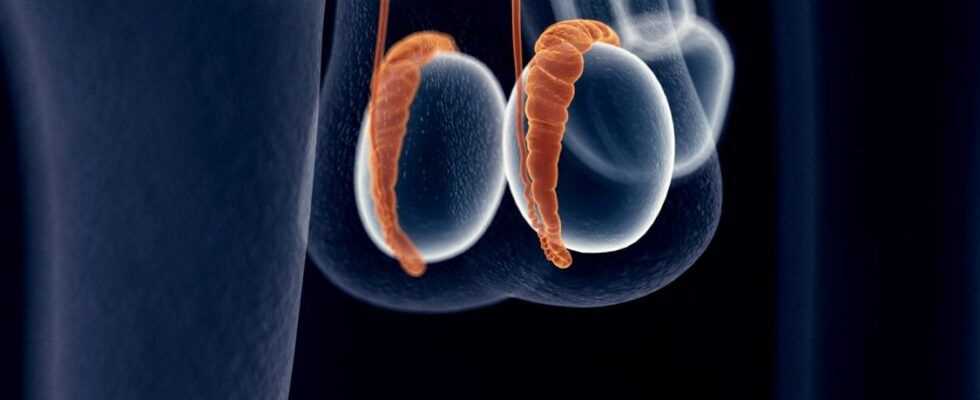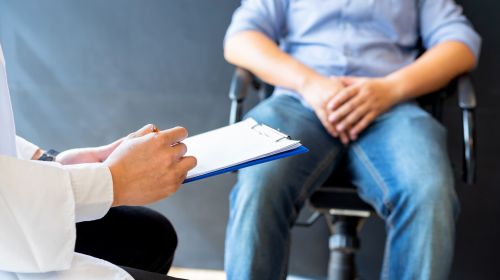Inflammation of the epididymis (epididymitis) causes swelling of the scrotum that is very painful. It is triggered by bacteria, which are often also responsible for urinary tract infections. The epididymis can also be the result of unprotected sex.
- The epididymis (orange in the picture) lie on the back of the testicles and can lead to severe pain if the epididymis is inflamed.
- © iStock.com/Eraxion
At a glance:
What are the epididymis?
The epididymis (epididymis) are part of the male sex organs. They are arranged in pairs, lie on the back of the testicles and are fused with them there. The lower ends of the epididymis go into the vas deferens. The sperm produced by the testes mature and store in the epididymis until they exit through the urethra during an ejaculation.
In the case of a urinary tract infection or an inflammation of the prostate, bacteria can get into the epidodes and cause inflammation there. Affected men recognize this from a very painful scrotum, which is also swollen and reddened. Most often only one side of the testicle is inflamed.
Frequency and occurrence
Epididymitis is one of the most common diseases of the male genital area. It often occurs in men when they become or are sexually active. In this case, sexually transmitted germs can cause the inflammation. But men over the age of 60 can also suffer from epididymitis more often. The most common reason for this is a recurring urinary tract infection and disturbed urination. If children have problems with a suddenly painful testicle, it is more likely to be a twisted testicle (testicular torsion), which must be treated immediately.
Causes of epididymitis
In most cases, epididymitis is caused by bacteria, such as
- E. coli (Escherichia coli),
- Proteus mirabilis,
- Klebsiella,
- Pseudomonas aeruginosa or
- Staphylococci.
These bacteria enter the epididymis via the urinary tract and vas deferens, especially in the event of a urinary tract infection or prostate inflammation. Men with an enlarged prostate or a narrowed urinary tract can usually not empty their bladder completely. This makes it easier for bacteria to settle in the remaining amount of urine, which repeatedly leads to inflammation of the urinary tract and the epididymis.
Unprotected sex as a trigger for epididymitis
Bacteria such as chlamydia and gonococci can also cause epididymitis. These are transmitted during unprotected sexual intercourse.
According to the Robert Koch Institute (RKI), however, 80 percent of chlamydial infections in women and 50 percent in men run without symptoms. That is, they go undetected and are not treated. In men, chlamydia can then migrate via the prostate to the epididymis and cause inflammation there. In women, an untreated infection can even lead to infertility or miscarriages.
Gonococci, on the other hand, cause gonorrhea (gonorrhea) – the third most common sexually transmitted disease worldwide. Ascending gonorrhea can cause prostate or epididymitis in men, among other things. This disease can also be symptom-free in men and women. Condoms therefore remain the most important protection to protect yourself against sexually transmitted diseases – but also to avoid passing on undetected infections.
Other possible causes
Other risk factors include indwelling catheters or injuries such as a bruised testicle.
Symptoms and complaints: this is how epididymitis manifests itself
Men with acute epididymitis suffer from severe testicular pain that can spread to the groin. Other symptoms are:
- A swollen scrotum
- Sensitive epididymis
- Red and warm testicles
- Discharge from the urethra, especially if you have a chlamydial or gonococcal infection
- Sometimes fever can also occur
- Possibly burning sensation when urinating
On the other hand, erectile dysfunction is not a symptom of epididymitis.
Diagnosis and therapy
The first point of contact for testicular pain is the urologist. This first examines the scrotum for typical signs of inflammation, such as redness, swelling and tenderness. In addition, the urine is analyzed in the laboratory to identify the germs that cause the disease. To rule out other testicular diseases such as testicular cancer, doctors often do an ultrasound as well. If a sexually transmitted disease is suspected, a swab is also taken from the urethra.
Treatment of epididymis
Epididymitis cannot be treated with simple home remedies. But bed rest, cool compresses, and elevating your testicles are the most important recommendations for relieving the discomfort. Elevation in particular helps many men. To do this, the person concerned lies on their back and places a small towel or gauze pad between their legs and the scrotum. The epididymis is relieved and the pain subsides.
In addition, the epididymis is treated with medication – usually antibiotics, because bacteria are the trigger for the inflammation. Pain relievers and anti-inflammatory drugs such as diclofenac or ibuprofen also help to alleviate the symptoms. If the pain is very severe, the doctor may also recommend local anesthesia of the spermatic cord.
If chlamydia or gonococci are the trigger for the inflammation, the partner must also be examined and treated. Otherwise there will always be a renewed infection and possibly also a new epididymis.
How long does epididymitis last?
Due to the antibiotic therapy, the symptoms subside quickly. It is important to keep taking the antibiotics as prescribed. If treatment is stopped prematurely, the disease can become chronic or lead to complications. It can take up to six weeks for all symptoms to subside and for the epididymitis to heal completely.
Possible complications
If the epididymis is not treated or if the treatment is stopped prematurely, it can develop into a chronic inflammation. This can then also pass to the second epididymis, block the vas deferens and lead to infertility. In rare cases, the affected epididymis even has to be surgically removed because the disease does not heal or the therapy does not respond. Men who suffer from scrotum pain should therefore always see a doctor. In this case, false shyness or shame can lead to permanent damage.
This is how men prevent epididymitis
Anyone who has problems or pain when urinating should clarify this immediately with a doctor. If an inflammation of the bladder or prostate gland is recognized and treated quickly, this can often prevent epididymitis. As a sensible prophylaxis to prevent a urinary tract infection, the following basically help:
- Drink enough
- Go to the toilet in good time – do not suppress the urge to urinate
- Empty your bladder completely
- Urinating right after sex
Beware, epididymitis can be contagious
Depending on the cause, epididymitis can also be contagious – for the sexual partner. If chlamydia or gonococci are the trigger, a chlamydial infection or gonorrhea also pose a potential danger to other women and men. The only preventive measure to protect yourself from it is sex with a condom – especially for those who have alternating sexual partners.


